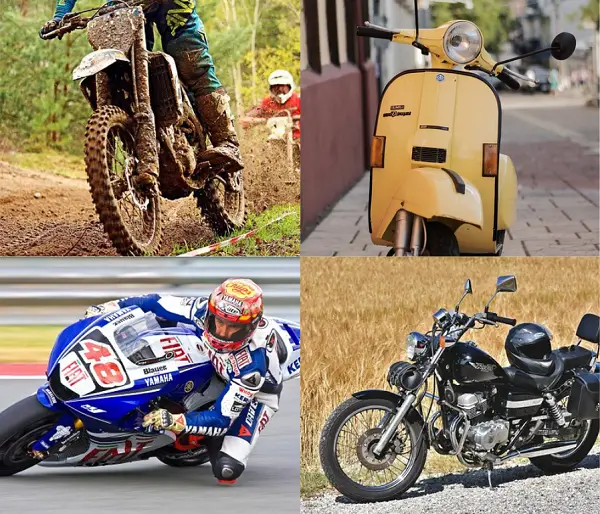Saving up for a motorcycle is a tough and trying job, but it’s only just the beginning. If you don’t know how to choose a motorcycle, you might end up with frustration.
There’s a lot to consider before you buy a motorcycle, with the first thing being the type. Motorcycles vary in style and intended use. Some are more comfortable than others, while some are designed for high-speed applications. It’s important to narrow down what type of motorcycle you want and why you want it.
Here’s how to choose a motorcycle for yourself that fits your body and your needs:
Type of Motorcycle
The first and foremost consideration you should make is the type of motorcycle. Different types differ in their engine power, tire size, speed rating, and intended use.
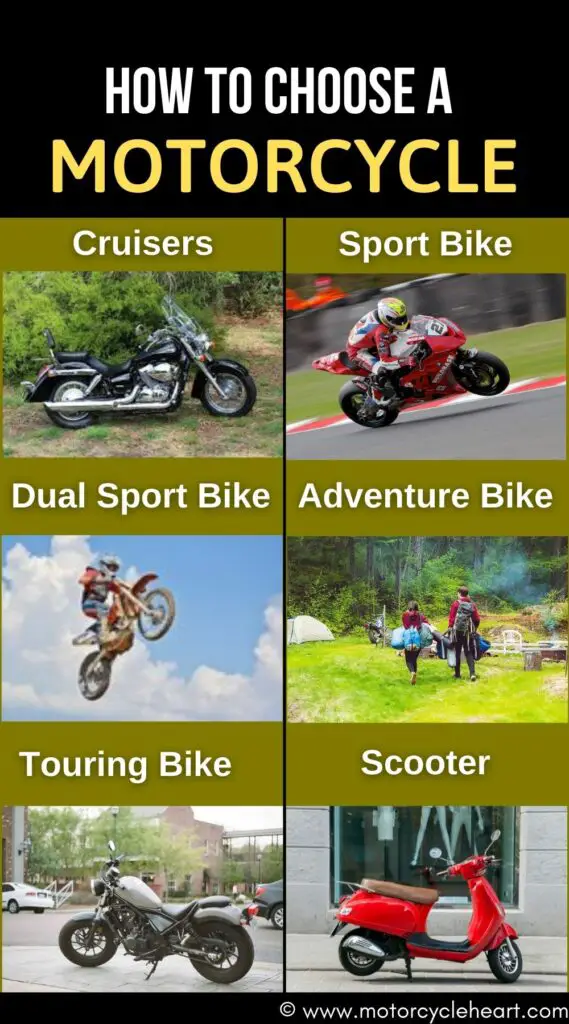
Cruisers
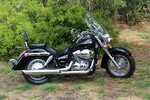
Cruisers are low-power bikes engineered for maximum comfort. Initially designed by Harley-Davidson, cruisers have now become popular due to their high comfort.
These bikes are characterized by their low seat height, which helps maintain a perfectly straight posture. In these, your feet rest above the ground in front of you, at a slight angle to your thighs. That makes for a more comfortable ride that won’t be strenuous on your back or neck.
As you may have guessed, these are a better fit for commuting rather than racing or touring. These bikes have a low-torque engine that can achieve top speeds fit for the road.
However, you may feel that the bike is heavier and harder to steer. Also, consider the fact that they’re only made for smooth roads.
Sport Bike

Sportbikes are just what you’d imagine them to be. They look premium with their engine covered up. And when you sit on them, your back leans forward, and your feet may be either behind you or under you.
These bikes are geared towards performance and speed rather than comfort. They have more powerful engines that are in the 600 cc to 1,000 cc range. They have a lot of weather protection, such as protection against water, dirt, and sunlight. You may also find their tires to be thicker, optimized for tough road conditions.
However, it’s important to know that these bikes have limited suspension and do not perform well off-road. They’re mostly made for high-speed applications such as racing or for driving on a smooth highway.
Beginners should steer clear of these bikes due to their intended use, uncomfortable riding position, and high cost. Anyone who isn’t into racing or driving at high speeds should avoid this.
Dual Sport Bike

Dual sport bikes are part-commuter, part-sport bikes. They are a cross between standard and sportbikes. They are intended for commuting as well as for riding at high speeds.
These look similar to standard bikes but with more comfortable positioning. Your back sits straight on the seat, and your feet rest under you, allowing for a long comfortable ride.
Dual sport bikes normally provide better control at the cost of speed. You should go for this if you want an all-purpose bike that can be used for commuting and traveling.
Adventure Bike

Adventure bikes are designed to take on anything and everything. They have excellent weather protection and a large luggage capacity. These look and feel much like dual-sport bikes, especially in the rider’s positioning. However, they differ in that they are more suited for off-road applications.
You’ll find larger and stronger tires here that can withstand water, rocks, and pictures. They can reach high top-speeds for cruising, but they’re not meant for such applications. Instead, what they compromise in speed, they make up for in their suspension.
Adventure bikes, as the name suggests, are for the regular adventurer. These are great for mountaineering, hiking, and hill-climbing.
Touring Bike
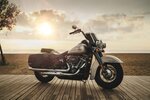
Similar but not equal to adventure bikes, touring bikes are the on-road counterparts of adventure bikes. These are made for touring on smooth ground, such as roads and highways. Some manufacturers may use the terms “Adventure Bike” and “Touring Bike” interchangeably. So be sure to confirm with them its intended use.
Touring bikes can run for miles at a time and can achieve significant top-speeds to cover long distances. However, they’re different from other bikes in that they have more space for luggage. They also have excellent weather protection.
But they’re not made for heavy-duty off-road use. That’s what an adventure bike is for.
Standard Motorcycle

The name says it all. Standard motorcycles are the most common types of motorcycles that are described as “all-purpose.” They’re great for both commuting and a bit of off-roading.
These bikes look similar in style and shape to cruiser bikes, but with one major difference: the positioning. In a standard bike, your back is slightly inclined forward, and your feet are under you.
You may have seen these bikes being used as commuters. And chances are you probably already have/had one. Standard bikes can also be used off-road to some extent. They’re not made for high-speed applications but do offer some level of suspension. And they can be cheap, just like scooters.
Scooter
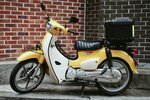
Finally, we have the scooter. Scooters are extremely low-power motorcycles that have 50 cc to 650 cc engines. These are common commuters that are available at a low price. There are two key differentiating factors here.
Firstly, scooters have a step-through design that makes it easier for people who wear full-length skirts or cloaks or short people who can’t mount a regular-sized bike.
The second difference is that scooters have a continuously variable transmission (CVT). It means you don’t have to shift gears, and as such, you don’t have a clutch.
Scooters are designed to be easy to use. They have a narrower learning curve, require low maintenance, and often offer storage. They’re great for commuting.
However, they fail at everything else because they’re not made for high-speed applications, have minimal suspension, and cannot perform off-road.
How to Choose a Motorcycle – The Right Fit
After you decide on the type of bike you want, consider the fit. The simplest way to find the right fit is to sit on the bike. See if your feet can reach the controls and if your hands can reach the handlebars.
If you’re not comfortable, don’t worry. Many bikes offer some level of adjustment. Look for an adjustable seat and adjust it until you feel comfortable.
In addition to that, you may adjust the suspension and thus lower the height of the seat or the entire bike. You may also be able to replace the seat with a more comfortable one. However, such adjustments will impact several buying factors.
For instance, on a sportbike, the seat is higher to allow for better suspension. By adjusting the suspension or lower the seat, you’re compromising on a smooth off-road experience. Only do so if you’re using your bike on smooth roads.
Similarly, adjusting the seat height and angle may shift your weight uncomfortably. This might make it harder to use the foot controls. Plus, fiddling with the suspension can void your warranty.
How to choose a motorcycle – New Vs. Used
Let’s face it: bikes are expensive. Even if you know how to choose a motorcycle, the price may put you off. This is why so many people are resorting to buying used bikes. It helps prevent waste and saves you a lot in the long-run.
Used bikes are good for those people who can’t afford new ones; that bit should’ve been obvious. But there’s also another reason you should buy used bikes: your indecisiveness.
If this is your first time buying a bike, it’s recommended to try out a used one and find out where your interests lie. You may buy a commuting bike only to find that you like to venture off-road often.
To avoid regretting the choice, later on, it’s better to buy a used bike of what you think is your type. After a year or two of riding and developing your interests, you may want to upgrade to a different bike. And that’s when you should buy a new bike. You can even sell your old one and gain a decent amount of money.
FAQ
How Much Is Engine Power Suited for Me?
Motorcycle engine power is measured in terms of its capacity, in cc. Most beginners get off well with just 150 to 250 cc engines. Anything above that is good for people who have more experience. For experts and professional racers, anything above 850 cc is recommended.
What Are Some Good Quality Brands for Motorcycles?
Harley-Davidson is the first to come to mind. It’s the oldest reliable brand that has even pioneered some new motorcycle categories.
Honda and Yamaha are close-contenders, and their bikes are readily available in many parts of the world. You might have to settle for local sellers.
Conclusion
Motorcycles are the best for commuting, touring, exploring, and racing. They’re convenient for running your everyday errands as well as for taking a day off. But no one motorcycle can do it all.
Now that you know how to choose a motorcycle, you have many options at your disposal. If you like venturing off-road and taking more risks, consider a bike suited for adventuring. And if you like racing, consider a sport or dual-sport bike. But if you just need a convenient means of commuting, you’re better off with a standard bike or a scooter.
Whatever the case, be sure to buy a bike that fits you. Check for height adjustments and the right rider positioning.

